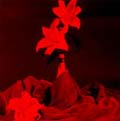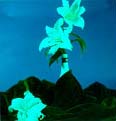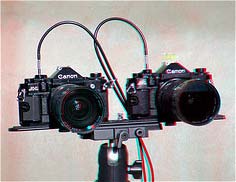
 | ||||||||||||||||||||||
  3D Aviators The only way to show stereoscopic images with a single projector is through looking at an Anaglyph through the typical red-blue color filter glasses. See image below. Basically, anaglyphs record stereo information as color. In making Anaglyphs, 2 cameras are spaced equidistant from an object and rotated in towards it. The separate images are then overlapped slightly with the 2 colors. The colored glasses filter out information to force our eyes to cross the images into one. This mimics the stereo process that occurs with our eyes. Generally, the red lens goes over the left eye, and the cyan goes over the right eye.
If both images are superimposed on each other, it is just like a flat image that is seen right on the screen. If the images are uncrossed, with 2 duplicate images right next to each other, the left eye sees the left image and the right eye sees the right image. They converge at a point behind the screen so the image is seen as farther beyond in space. If the images are crossed, the left image is seen to the right and vice-versa. This tricks the eye into thinking that the image is really in front of the screen. Thus, with a different shift between left and right images, you can place the image either in front of or behind the screen. Interestingly, according to Perry Hoberman, if you take 2 identically sized images of Godzilla and have one appear as if it is projecting towards you, that closer image will be perceived as smaller. Why is this? The brain is telling you that if something is closer to you and making the same exact image on your retina as something perceived as farther away in depth, then the first image logically must be smaller.
Beware! Old stereoscopy can give headaches! During the stereoscopic boom of the 1950's, the precise technology to display stereoscopic films was not solidly in place. If a projectionist pointed a camera straight ahead or did not accurately display the 2 separate images, the brain would have to work in hyper-drive to cross the images into one. The worse the alignment was, the more the viewer's eyes would hurt.
In our seminar, Perry Hoberman conducted a live demonstration using lines on a computer screen (similar to how wireframes are used in 3D software programs) to demonstrate the following (paraphrased below): "Motion parallax is another factor that clues our brains into the depth distance and relationship between objects. For example, rotating a series of lines will clue you in that it is a 3D image. If you want to know where something is on a flat screen, you have to rotate it. Both motion and binocular technique are utilizing disparity. Things at different distances move at different rates or have different degrees of separation. If a stereoscopic effect is applied to the lines however, a viewer can instantly see the depth relationships and position of objects on a still image without needing to rotate it."  This principle is being utilized for scientific 3D visualization Possible Stereoscopic Camera Set-Ups: - 2 eyesight cameras side-by-side - not made anymore but built into computers.
- Hypo (close together) 2 cameras shooting at an angle into mirrors (often used in a situation where the cameras are too big to place side-by-side facing forward)  In this 4x5 pinhole camera example, 2 auto mirrors approximate the angle of view. - Hyper (far apart) 2 cameras far apart to take stereoscopic images of something far away, like a mountain  Single Camera set-up Do you want to see like a bug or Godzilla? Hyper stereo miniaturizes things as if you're a very big creature with your eyes spread far apart. Hypo stereo is like being a very small creature with eyes close together so things look really big. |
[page 1] [page 2] [page 3] [page 4]
Return to main Page









